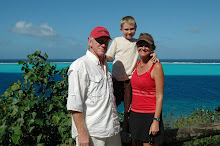Yesterday we toured the island of Vanua Levu with Jimmy, our Fijian guide, and learned much about Fiji and its people.
Vanua Levu is the second largest island in Fiji and has two distinct climates zones divided by an interior mountain range. On the damper southeast side, copra farming (coconuts used for oil) is the main agricultural industry while sugarcane and pine forests grow in abundance on the dryer northwest side. On the north side, miles of narrow railroad tracks criss-cross the countryside for the sole purpose of transporting sugarcane to the large government-owned mill. The island is littered with small Fijian villages and a main market town on each side of the mountain range. Labosa, the northern town, was our main destination for the tour where we meandered through the market while Jimmy identified unfamiliar fruits and vegetables for us. Savusavu is the market town on the southeast side, where we are anchored in its harbor.
Near the towns, you will find many Indo-Fijian people - descendents from indentured laborers recruited in the late 19th century to work the sugar fields. Although the Indo-Fijians and native Fijians have developed a peaceful co-existence on Vanua Levu, their distinct cultures continue to be obvious in dress, language, religion, food and customs. For example, no Fijians work on Sundays but the Indian shops are open. In other parts of Fiji, tensions between the races continue to be a contentious political matter even 125 years later. Having become an independent republic (under the Commonwealth of Nations and the Queen of England) in 1970, government instability has plagued Fiji ever since, with full blown coups as recently as 2006. The balance of power between Indo-Fijians and Fijians is out of whack. Fijians own most of the land while Indo-Fijians dominate commerce. Even though racial tensions here are subdued, we heard prejudice in our guide Jimmy. He warned us that Indian merchants will charge higher prices to tourists, a practice he found dishonest and dispicable. (We experienced this ourselves when Eric bought the same batteries ranging from $2 to $15!) He told us Fijians do not care about money. They strive to earn only what they need and no more. Indians want more and more, a concept Fijians, and much of native South Pacific, do not understand.
Another tour stop was to Naag Mandir, a Hindu temple designed around a serpent-shaped rock that represents the Hindu snake god. This rock reportedly grows, so much that the roof of the temple has had to be raised to accommodate its larger size. Never having seen a Hindu temple before, I was intrigued by its bright colors and amusement-park architecture qualities. At the top of the 108 steps to view manequin representations of importants gods, I expected there to be a water slide. Each step represents a blessing so the steps were built half-size to create more steps and make climbing easier. Two young Indian girls were there pouring milk offerings to the snake god and others had left food. One of Jimmy's sisters converted to Hinduism so he was able to explain some of the rituals. It seems to be an interesting religion.
Our final stop was the Palmlea Lodge built five years ago and run by friendly ex-cruisers, Joe and Julie. Lunch was fabulous and I got an Indian Pumpkin recipe from the Fijian cook. Bear and I swam in the lap pool while Joe told Eric about his Boer goats that he is breeding to increase the meat yield per animal.
We are just beginning to explore Fiji but so far we are loving it!
skip to main |
skip to sidebar

Eric, Annie and Bear

These are the travels of the Bloomquists aboard our Nordhavn 64, Oso Blanco.
Follow this Blog by email
The Bloomquists

Eric, Annie and Bear
About the Boat

- Oso Blanco
- Oso Blanco is hull 6409, manufactured by Nordhavn in Taiwan. She is 64 feet long, has a 21' beam and 7' draft. Return to home page and click "About the Boat" to learn more.